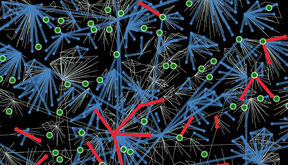Skype data of 500 million people reveals the real patterns of social adoption

Local adoption cascades are initiated by multiple spontaneous adopters arriving at a constant rate, amplified by a large number of adoptions induced by social influence, and controlled by individuals who are immune to the actual adoption.
This study shows that the structure of real-world adoption clusters is radically different from previous expectations. Vulnerable adoptions, induced by a single adopting neighbour, appear to be important only locally. Instead stable adopters, who are initially resisting to be exposed, are actually responsible for the emergence of global social adoption.
This study is based on an observation of paid service adoptions over the period 8 years on the social network of Skype that connects over 500 million people all around the world. The data was explored with analytics methods, using mathematical modelling and statistical techniques. A behavioural threshold theory from sociology was used to categorise people by how susceptible or immune they are to other people's decisions.
‘Our observations and model help to understand the underlying structural differences between emergent global patterns of adoption spreading. We explain why some cases of adoption processes, like online memes or information cascades, emerge rapidly, while others, like adoption of products or services, evolve with a moderate speed’ explains Márton Karsai, assistant professor at Ecole Normale Supérieure de Lyon with INRIA research chair, and AScI visiting researcher at the Department of Computer Science at Aalto University.
According to the study, people can be classified into three groups the way they adopt new ideas. Innovators are spontaneous with their own ideas, and they have the necessary connections to effectively influence others. Socially-influenced individuals include both the susceptibles, getting easily influenced by other people, and the stables, who may be influenced but need stronger impact before getting convinced. In addition, there is always an immune or unconcerned population who will never become adopters no matter what others do around them.
‘Following the relation and dynamical evolution of these four sets of individuals, we identified the important ingredients that induce and control global adoption cascades. First of all, we observed that the thresholds of social influence necessary to adopt vary strongly among individuals. Innovators arriving with a constant rate help induce fragmented, small and local adoption clusters of vulnerable users in far apart areas of the network. Moreover, innovator and vulnerable adopters convince a large number of stable adopters, which in turn connect the local adoption cascades and lead to the emergence of global phenomena. However, the immune population plays a strong control on the dynamics. If they are present as a large fraction, they dilute the system and in this way slow down or maybe even block the evolution of any global pattern’ continues Karsai.
'This study can be useful in understanding, for instance, the trends in fashion and popularity of political figures. You may see weak and early-warning signals of a contagion phenomenon and then be able to predict whether it will spread fast or slow, locally or globally', tells Gerardo Iñiguez, visiting researcher at the Department of Computer Science at Aalto University, and assistant professor at the Center for Research and Teaching in Economics (CIDE, Mexico). As he explains, ‘Initially there is always only a small amount of people with a certain opinion. If you locate these early adopters strategically in a society, you can have more people joining any movement. Targeting messages to the right people, i.e. to early adopters, is in this sense very important. Marketing campaigns may also be further developed by knowing the type of people that simply cannot be convinced.’
‘Our observations were based on one of the largest online social systems ever built, and made available for research. However, future work needs to be carried out to characterise exactly how contagion works in other social settings, including different online products and services, as well as in the spread of ideas, political movements, etc.', the authors conclude.
Márton Karsai from ENS de Lyon and Riivo Kikas from the University of Tartu and STACC worked on the data analysis. Gerardo Iñiguez and Márton Karsai developed and analysed the threshold model. Professors Kimmo Kaski from the Department of Computer Science at Aalto University and János Kertész from Central European University supervised the study.
More information:
Márton Karsai
Assistant professor with INRIA research chair
Ecole Normale Supérieure de Lyon, INRIA, IXXI Rhône Alpes Complex Systems Institute
Gerardo Iñiguez
Assistant professor
Center for Research and Teaching in Economics (CIDE)
Kimmo Kaski
Professor
Department of Computer Science, Aalto University
Article:
M. Karsai et al., Local cascades induced global contagion: How heterogeneous thresholds, exogenous effects, and unconcerned behaviour govern online adoption spreading. Scientific Reports 6, 27178 (2016). doi:10.1038/srep27178
Read more news

Get to know us: Associate Professor Maria Sammalkorpi
Sammalkorpi received her doctorate from Helsinki University of Technology 2004. After her defence, she has worked as a researcher at the Universities of Princeton, Yale and Aalto.
Aalto computer scientists in ICML 2024
Computer scientists in ICML 2024
In low-hierarchy organisations, even key policy issues are discussed in Slack
In a recent study, Aalto University alumn Lauri Pietinalho, a visiting scholar at New York University's Stern School of Business, and Frank Martela, an assistant professor at Aalto University, investigated how low-hierarchy organisations deal with shared policies in confrontational situations and how authority functions within them.